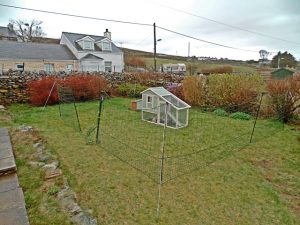 Fencing Protection for Free Range Poultry
Fencing Protection for Free Range Poultry
Traditional wisdom has always valued the adage, ‘Good fences make good neighbours.’ As far as the free-range enterprise is concerned, good fences also make good sense! Without them, the depredations of the fox would make a mockery of any effort to keep poultry. In addition, wandering dogs, feral cats, mink, badgers, even polecats in some areas, may prove hazardous to chickens.
Fencing is also required to control the birds’ access to pasture, so it is appropriate to regard fencing in two ways:
- external or perimeter fencing to keep out predators
- internal or pasture control fencing to restrict the movement of chickens to certain areas
Perimeter Fencing
This should separate the poultry farm from the outside world. There is no easy or cheap way of doing this and it is one of the most substantial costs facing anyone thinking of starting a free-range poultry farm.
Fox Protection
A determined fox can scale a fence, although to go back over it carrying his prey may prove too much for him. However, that is a hollow victory for the poultry-keeper if the fox has already killed several birds. The vixen, hunting for her young ones in early spring, will often kill many birds, biting off their heads, then making off with one, leaving the other corpses behind.
A 2 m high perimeter wire mesh fence of will provide adequate protection, as long as there is a further overhang of 30 cm placed at an angle of 45° to the vertical. The overhang should project outwards to repel boarders.
Some poultry keepers claim that to have the top strained and projecting outwards is unnecessary, and that merely having a 30 cm section, loose and unstrained at the top, will dissuade a predator because it will not provide sufficient support for scrambling up it.
Mink Protection for Poultry
Wire mesh netting with 50 mm holes in the mesh will deter foxes. Mink can still climb a fence and wriggle through holes of this size. However, they are more likely to be a problem in areas close to rivers. In such situations, trapping may need to be considered, and the Ministry of Agriculture should be consulted for advice on suitable traps and procedures. In some areas it is possible to borrow traps from the authorities.
Electric Fencing
The bottom of the wire mesh needs to be dug well into the ground to prevent predators from pushing their way underneath. The provision of an electrified wire will give added security to the fence, in this respect, if it is placed 25 cm above the ground and 25 cm out from the mesh. Placing a second wire near the top, or just above the fence, 10 cm out from the mesh, will make the barrier virtually invulnerable.
A high-power mains fencer unit is recommended for a permanent fence of this kind, because it needs less maintenance than a battery-operated one. Wiring should never be connected directly to the mains supply and the advice of a specialist should be sought before installing such a system.There are many suppliers of electric fencing who are experienced in the needs of poultry keepers, and who supply fences which conform to the British Standards Safety Requirements.
If an existing fence is electrified, the cost is about half that per metre of installing a new one.
Extract from Free Range Poultry by Katie Thear
Widely recognised as the definitive guide to modern free-range poultry management, Free Range Poultry is a practical and comprehensive guide that is up to date with legislation and research findings. These articles on land management in free-range poultry systems are extracted from the book.
Further Articles on Free Range Poultry
- Fencing for Free Range Poultry – Free Range Poultry Fencing
- Flock Density Regulations for Free Range Poultry
- Free Range Poultry Land Management
- Nature of the Land for Free Range Poultry
- Paddock & Pasture Rotation for Free Range Poultry
- Paddock Management for Free Range Poultry
- Sheltered Areas for Free Range Poultry – Free Range Poultry Shelter

